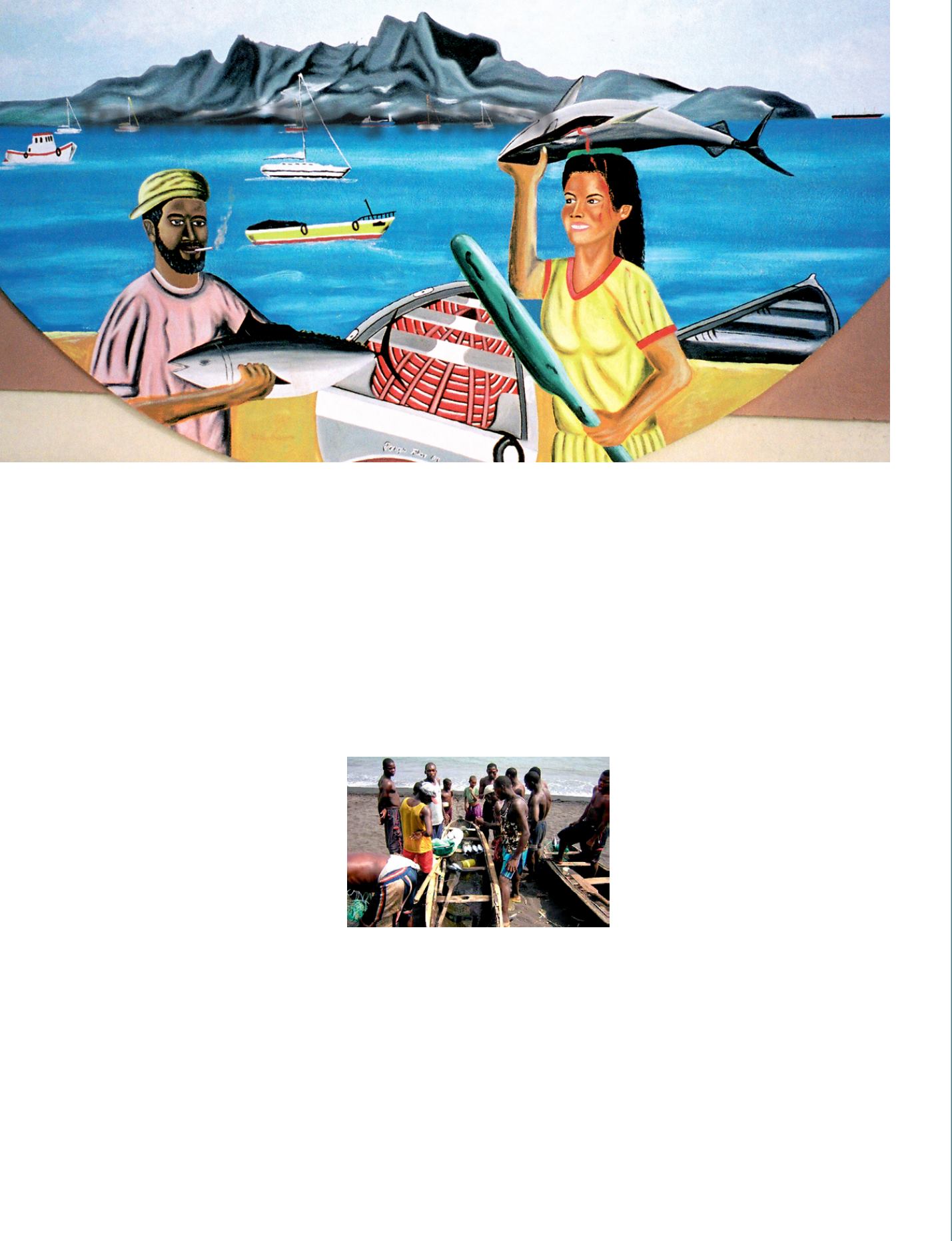
Traditional fishing evolution
86 - Sustainable Development in Africa & Satellites
L
ocated in central Africa south of the
equator, the São Tomé and Príncipe
archipelago
possesses
fishery
resources that could play an important role
in its economy and in food self-sufficiency.
The archipelago has an exclusive economic
zone (EEZ) that is large for the region
(160 000 km
2
) in which abundant fishery
resources are concentrated from May to
October as a result of the local mingling of
masses of water in the Gulf of Guinea. The
catches of small-scale fishing represent
70% of the animal protein required by the
population and nearly 30 000 people (20% of
the population) depend directly or indirectly
on this sector for their survival. However,
São Tomé and Príncipe profits little or not
at all from its rich waters and small-scale
fishing is experiencing an inevitable crisis
with disastrous effects in the short term for
the population of this small country that is
one of the poorest in the world.
The first problem is that the state does not
have sufficient capability to control this vast
maritime territory and, unfortunately, the
resource is pillaged by a foreign industrial
fishing fleet with few scruples. Then there
is a lack of means. Fishing is still carried
out on a small scale by under-equipped,
little-organised fishermen. Their dug-out
canoes are heavy and not easy tomanoeuvre
and they cannot go far enough from the
coast to exploit pelagic resources that are
nonetheless abundant in the EEZ. To this is
added the use of techniques with disastrous
effects—explosives, seine fishing with a net
whose mesh is too small—that regulations
that are too timid cannot control. On land,
the female fish sellers, going by the local
name ‘Palaiés’, have difficulty in selling
the catches. There are no storage facilities
for fish and processing capacity is small,
conditions of hygiene are inadequate in
village communities, the local market is
small, etc.
Since the end of the 1990s, a small São
Tomé non-governmental organisation has
nonetheless tried to change the situation.
The goal is the modernisation of traditional
techniques and the stimulation of sales
chains. The NGO MARAPA (Mar Ambiente
e Pesca Artesanal) has thus succeeded in
introducing prao type outrigger canoes that
are more suited to navigation conditions.
For several years it has tested the use of
fish aggregation devices (FAD) in the high
seas that will in the future enable fishermen
willing to sail far from the coast to maintain
reasonable catches. With the support
of various partners, it has performed
numerous actions to promote awareness
and to provide training in responsible fishing
techniques that conservemarineandcoastal
ecosystems at the national scale, has shown
fish sellers better practices for processing
(drying, salting, smoking) and better sale of
catches.
In recent years, with the support of the
government of São Tomé and Príncipe and
IFAD (the International Fund for Agricultural
Development), MARAPA has concentrated
its work on the structuring of a chain for the
sale of fresh fish packed in ice between the
capital and the isolated, richer fishing zones
southof the island of São Tomé. Afish selling
cooperative has had technical assistance
from the NGO since 2005, especially for the
conservation of fish in ice and transport to
the capital.
However, MARAPA runs up against
numerous obstacles. For example,
strong resistance to change in village
communities with deep-seated traditions
and enormous logistic difficulties in a
country with decaying infrastructure.
This means that the achievements of the
project are mixed and its survival cannot
be guaranteed in the long term.
But São Tomé fishing does not have the
choice if it wishes to survive. Current
practices are not viable and there are already
signs of the exhaustion of coastal resources.
Ongoing rural exodus towards coastal urban
areas will irremediably increase the food
dependence of a strongly growing population
on fishery products. In the light of the
issues, the actions of MARAPA are terribly
necessary but seem clearly insufficient.
c
Bastien LoloumZuntabawé
Largo BomDespacho
RepúblicaDemocrática
de São Tomé andPríncipe
i
Santa Maria fishing port (Cape Verde). Wall painting showing the importance of fishing in the island and especially tuna.
©Marie-Noëlle Favier / Indigo / IRD
i
Small-scale fishing provides 70% of the animal
protein required by the population of the archipelago.
©MARAPA


